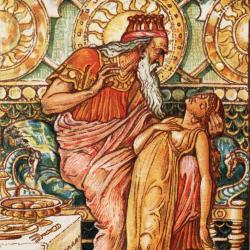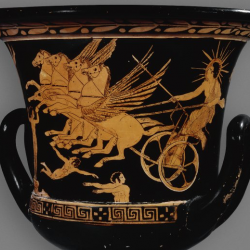You are here
Week 1
The first week is a good opportunity to set the tone for listening and discussion and to establish the history enquiry. The theme for this week’s stories is Choices, and the history topic is the Greek language and an introduction to the ancient Greek world. In the lead story, King Midas 1, a king discovers the disastrous consequences of an ill-judged choice. In Phaethon, a young man pays ultimate price for not listening to his father’s advice.
History materials
- Main topic
- Key ideas
- Making the link
- Teaching the topic
Greek language
Language was one of the most important factors that identified the Greeks as Greeks even though different groups of Greeks spoke different dialects. The earliest documents in Greek date from around 1300-1200 BC, but the language itself was much older and was brought to the region by migrants who cannot now be identified. The Greek language has contributed many words to English especially general and specialised concepts and terms in science and across all other academic and professional subjects and disciplines.
Greek gods
The Greeks believed in numerous gods and divine beings with different levels of power and influence on their lives. Different Greek cities privileged different deities, for example, Athens and Athena, Corinth and Poseidon. Worship took place at a public, city-sponsored level and also at a private level, where some of the minor deities were often more significant than the great Olympian ones.
Identity
Communities of people who regarded themselves as Greek were widely dispersed around the Mediterranean and Black Sea region. Two of the most important bonds that brought these communities together as Greeks were religion and language. They also shared certain approaches and styles in art forms such as literature and architecture, and in how they organised their societies. Some of these are covered in other story topics.
Gods
The Greek gods were visualised in human form, displayed the same emotions as human beings and behaved in similar ways. In myths, the gods often interact with humans. These interactions can be benign or disastrous and help stress the need to remain on friendly terms with the gods and to be conscious of their presence and powers.
You could use two central links from the story into the historical topics: 1) the god Dionysos and his followers, Silenos and the satyrs, and 2) the river Paktolos where Midas washes off the golden touch.
The gods
Rather than using Dionysos as an opportunity to introduce all the gods at once, you can build up the children’s familiarity with the gods and other divine beings gradually over time using the stories as the basis for understanding what they were like — see Teaching the topic.
Why not start with the story? Identify the divine beings in the narrative: Dionysos, Silenos and satyrs. Ask the children what we learn about each of these. Focus discussion on Dionysos. The storyteller tells us that he is god of certain things, but the children might have their own take on his character and his behaviour towards Midas. You could compare the children’s ideas with these two paintings:
Painting of Dionysos and his companions:
This painting by the sixteenth century Italian artist Titian gives a vivid impression of the wild revelling associated with Dionysos and his followers. The Roman name for Dionysos was Bacchus. The image can be zoomed very large to show details.
This seventeenth century painting, perhaps by Sir Anthony van Dyck, shows a drunken Silenos. It can be zoomed and made full screen.
The Greek world
You might want to show the children a blank map of the Mediterranean area, including the Black Sea in the east and Spain/Portugal in the west. Identify the peninsula of mainland Greece.
Pick out from the story the two place names mentioned: Mt Olympos (in northern Greece) and the river Paktolos (in Turkey). You could set the children the task of finding where these two places are and marking them on the map. Draw the children’s attention to the fact that Paktolos is not in what we think of as Greece today, and discuss why it might be in a Greek story to alert children early on to the notion that the Greek world was not confined to Greece, and was in touch with and open to other cultures around the region. You might ask the children about what sorts of things bind groups of people together.
Greek gods and their roles
You might like to begin a display chart or a set of god and goddess files for the Greek gods and divine beings. These could be either in hard copy on the wall or as digital files. Add what the children have learned about Dionysos, the satyrs and perhaps Silenos. Build the chart/files up as you go through the stories and other evidence. You could create a table like this, with three columns or headings:
| Name | Stories and pictures | Things they do, how they behave, what they are like |
|---|---|---|
|
Dionysos |
Midas story 1 |
|
Take a look at the pot paintings of Dionysos below. You could remind the children that the story refers to Dionysos as ‘the god of drinking and drunkenness, wild music and wild dancing’. Discuss how this is reflected in the pot-paintings. They will see several satyrs, but may need help identifying the drinking of wine and the connection between grapes and grape vines and wine. Notice Dionysos’ name on the pot painting of Dionysos drinking — see Language later in these notes.
This painting from the inside of a wine cup shows Dionysos playing a lyre and singing with his head thrown back. He wears a wreath of ivy and is surrounded by tendrils of grapevine. Two satyrs dance alongside with castanets in their hands. Notice the snub noses of the satyrs and their pointed ears and horse’s tails.
Pot painting of Dionysos drinking:
This painting on a wine jar shows Dionysos drinking from a deep wine cup amidst a grapevine that has crept across the whole surface of the pot. Amidst the vine tendrils are small satyrs who are picking the bunches of grapes and putting them in baskets. One of the satyrs has put his foot in a basket ready to get started treading the grapes to make wine. There are several views all of which can be zoomed and right-clicked for save or copy.
By the end of this week, if you have studied both stories, the children will have encountered the following gods and divine beings:
Dionysos
Silenos and satyrs
Helios
Zeus
Hades
You might ask the children why the Greeks would worship a god like Dionysos; they should base their views only what they have learned so far from the story of Midas. This could be a question you ask them periodically based on a particular story or more generally on what they have learned about gods.
The geography of the Greek world
If you do not have time to do any of the longer activities below, you could just use the Map of Greek colonies to show how widespread Greek communities were around the Mediterranean; perhaps touch on the idea of what held them together.
A zoomable map of Greek colonies around the Mediterranean and Black Sea. It shows all the colonies listed in the Teaching ideas and most of the other sites.
Here is a list of cities and other places where the Greeks lived. You might ask the children to find out where they are and add them to the map you started with Mt Olympos and Paktolos. Where it is different, the Greek spelling or name is given in case the children would like to convert them into Greek letters — see Language below.
Olbia, Sinope, Istros, Byzantium (Greek: Buzantion), Ephesos, Chios, Miletos, Halikarnassos, Xanthos, Rhodes (Rhodos), Naples (Neapolis), Cyprus (Kupros), Naukratis, Kyrene, Athens (Athenai), Sparta, Corinth (Korinthos), Thebes (Thebai), Larissa, Delphi (Delphoi), Delos, Crete, Tarentum (Taras), Syracuse (Suracousai), Agrigento (Akragas), Rhegium (Rhegion), Marseille (Massalia), Dodona, Alexandria, Ampurias (Emporion), Paestum (Poseidonia)
You could read the passage from Plato on the Greek world sheet below and look at the map of Greek colonies (see above). Discuss whether Plato’s comparison with ‘frogs around a pond’ is a good one to describe where the Greeks lived. This might be an opportunity to discuss more generally why people move from one country to another. You may want to add the river Phasis (on the east coast of the Black Sea) and the Pillars of Herakles (the strait of Gibraltar) to your class map.
Greek world information sheet:
An information sheet for children about how the Greeks spread around the Mediterranean and the Greek view of the world.
The children might read about Hekataios on the Greek world sheet (see above) and look at his map. Ask them to find Hekataios’ home town and notice that this is a Greek city outside Greece itself. You could discuss what the map tells the children about how the Greeks saw their world. The Mediterranean region is clearly thought of as the centre of the Greeks’ world with other regions grouped around it — you could consider how modern world maps can differ from each other, with Britain or the Pacific Ocean in the middle or the Philips and Mercator projections. Identify that Hekataios clearly had knowledge of other parts of the world and tried to relate these to what he knew best.
Language
The topic of the Greek language emerges from the wide distribution of Greek communities. The Greek language bound the Greeks together not just in its spoken form, but as the medium of a shared literature, in particular the two long epic poems of Homer, the Iliad and the Odyssey.
Why not look at the Greek alphabet sheet below? Look at how the Greek alphabet, along with the names of the letters, has derived from the Phoenician. You may need to draw children’s attention to the fact that the word alphabet comes from the first two letters of the Greek alphabet.
Greek alphabet information sheet:
An information sheet for children explaining the origin of the Greek alphabet and giving the alphabet in full, with pronunciations. Some ancient Greek inscriptions are given for children to work out using the alphabet table. The names ending in ‘s’ are male, all the others are female.
You could ask the children to use the sheet to work out the English for the inscriptions given on the sheet. It was usual to use all upper-case letters in inscriptions. Go back and find Dionysos’ name on the pot painting of him drinking. The children might enjoy using the alphabet to write the names of Dionysos, Midas and Silenos and of some of the places listed earlier in the Geography section of these notes. They will probably not need prompting to try writing their own names in Greek!
You might try using the Greek language sheet below to help the children understand how language served to unite the Greeks and distinguish them from others.
Greek language information sheet:
An information sheet for children about the Greek language and how it served to link the Greeks together culturally. There is also a brief explanation of how Greek has come to be an important component in English and a few examples are provided of common English terms that are derived from Greek.
The information about words in English that come from Greek could be used to start a large activity identifying more examples and adding to those given. Work on the derivation of English words they know and use can help children’s word power by creating families of words.

